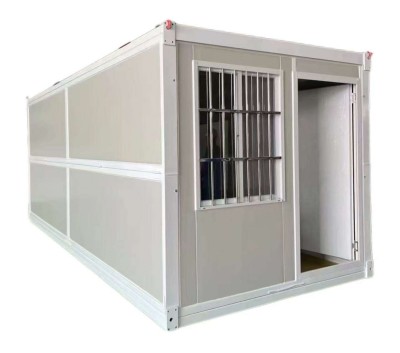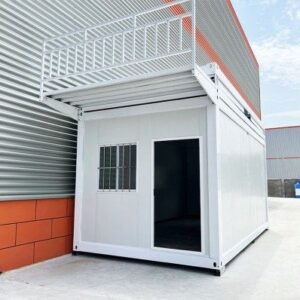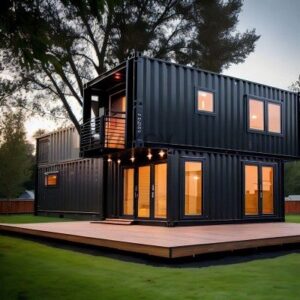If you’re wondering how much container house cost, you’re not alone. Whether you’re dreaming of an affordable, eco-friendly home or just exploring alternatives to traditional housing, understanding the real expenses behind container homes is crucial. In this guide, you’ll get a clear, no-fluff breakdown of the container house cost—from buying the container itself to customization, permits, and everything in between. Ready to find out what it really takes to build your own container home? Let’s get started!
Understanding Container Houses and Their Cost Advantages
A container house is a home built using steel shipping containers as the main structural element. These containers, originally designed for cargo transport, are repurposed into livable spaces, offering a unique alternative to traditional homes. Container houses have gained popularity due to their cost-effectiveness, quick construction time, and environmental benefits.
Common Types and Sizes of Shipping Containers for Homes
Shipping containers come in standard sizes, most notably:
- 20-foot containers (approx. 160 sq ft) – ideal for tiny homes or compact living spaces
- 40-foot containers (approx. 320 sq ft) – better suited for larger rooms or multi-container designs
There are also high cube containers, which are taller by about a foot, providing extra headroom—a popular choice for more comfortable living spaces. These standard sizes allow for flexibility in design, from single-container studios to multi-container family homes.
Advantages of Container Homes Including Cost Effectiveness
Container houses offer several distinct benefits:
- Cost-effectiveness: Containers are often less expensive than traditional building materials, especially when using used shipping containers. This lowers the initial building cost substantially.
- Speed of construction: The basic structure is already in place, drastically reducing build times compared to traditional homes.
- Sustainability: Using repurposed containers reduces waste and reliance on new materials, contributing to a smaller environmental footprint.
- Modular design: Containers can be stacked or combined, giving flexibility in home size and layout.
These advantages make container houses an attractive option for those looking for affordable, eco-friendly housing solutions without compromising on style or function. For more details on container types and options, visit container options.
Average Cost of a Container House National and Local Price Ranges
When looking at how much a container house costs, prices vary depending on size, location, and how finished the home is. A standard 20-foot shipping container generally starts around $2,000 to $5,000 for a basic used unit. A 40-foot container—which offers more space—typically ranges from $4,000 to $7,000 just for the shell.
If you’re considering prefabricated container homes, which come partially or fully built from a manufacturer, prices usually fall between $40,000 and $100,000. These kits include modifications like insulation, windows, and basic interiors. More customized or larger designs naturally push the cost higher.
Regional Cost Differences
Costs shift a lot depending on where you build. Here’s why:
- Labor costs: Places with high contractor rates like California or New York tend to be pricier than states with lower wages in the Midwest or South.
- Material prices: Local prices for insulation, plumbing, electrical, and finishing materials can change the final bill significantly.
- Permits and regulations: Some areas have stricter rules that add time and fees, particularly in urban or high-demand zones.
- Site work: Land preparation costs, like clearing trees or leveling ground, vary by terrain and region.
For a clearer idea about costs and options, you can visit container house cost details to see examples tailored to different US locations.
of Average Base Prices
| Container Type | Cost Range (USD) | Notes |
|---|---|---|
| Used 20ft Container | $2,000 to $5,000 | Shell only |
| Used 40ft Container | $4,000 to $7,000 | Larger shell only |
| Prefabricated Container Home | $40,000 to $100,000+ | Includes standard finishing |
Remember, these are starting points. The final price depends heavily on your design, customization, and where you build.
Detailed Container House Cost Breakdown
When figuring out how much a container house costs, it’s important to break down the main expenses step-by-step. Here’s what typically adds up in your container house construction cost:
Shipping Container Price New vs Used
- New containers often cost between $3,000 and $5,000 for a 20ft unit and $5,000 to $8,000 for 40ft containers.
- Used containers can be cheaper, around $1,500 to $3,000 depending on condition, but they may require more repairs or modifications.
- Prices vary by supplier, location, and container condition, so shopping around is worth it.
Site Preparation Costs
- Includes land clearing, grading, and foundation work.
- Foundation options like concrete slabs or piers typically range from $3,000 to $10,000, depending on soil and terrain, which can add significantly to the budget.
- The complexity of your site impacts overall prep costs.
Design and Customization Expenses
- Architectural and engineering fees usually cost $1,000 to $5,000, depending on project complexity.
- Adding insulation, windows, doors, and framing are necessary for comfort and can range from $5,000 to $15,000.
- Installation of plumbing and electrical systems often runs another $5,000 to $15,000, depending on hookups and local building codes.
Labor Costs
- General contractor fees average 10% to 20% of the total construction cost.
- Specialized labor like welders, electricians, and plumbers may charge higher hourly rates. Expect labor to add roughly $10,000 to $30,000 for a typical container home.
- Labor costs fluctuate by region; urban areas tend to be pricier than rural ones.
Permits and Legal Costs
- Building permits and inspections can range from $500 to $3,000, depending on your city or county requirements.
- Zoning and land use approvals may also be necessary, adding time and potential costs if variances are needed.
Additional Features Impacting Cost
- Solar panels and renewable energy systems can add between $5,000 and $20,000 but improve long-term energy efficiency.
- Integrating smart home technology varies widely but usually starts around $1,000.
- Interior finishes—flooring, cabinetry, paint, and appliances—commonly add $10,000 to $25,000 depending on quality and style.
Understanding these individual components can help you plan your shipping container home cost breakdown accurately and avoid surprises during your build.
Container House Cost vs Traditional House Cost
When comparing container house cost to traditional homes of similar size, there are clear financial differences and trade-offs to consider.
Cost Comparison
| Housing Type | Average Cost per Square Foot | Notes |
|---|---|---|
| Container House | $100 – $200 | Includes most customization and site work |
| Traditional Home | $150 – $250 | Varies widely by materials and region |
Container homes generally cost 20-40% less per square foot than conventional houses. This is largely due to the reuse of shipping containers as the main structure, which cuts down on raw material costs and construction time.
Financial Benefits of Container Homes
- Faster build time means you pay less for labor and financing.
- Lower material costs come from the container shell being pre-made steel.
- Often, fewer foundation needs reduce site prep expenses.
- Energy efficiency can reduce ongoing utility bills with proper insulation and design.
- Ideal for locations where traditional building is expensive or slow.
Trade-offs Compared to Traditional Homes
- Customization limitations: Container size and shape limit layout flexibility.
- Insulation and HVAC needs: Steel containers require adequate insulation which adds cost.
- Resale value uncertainty: Container homes may face slower resale or appraisal challenges.
- Zoning and permit hurdles: Some areas have stricter rules for shipping container dwellings.
- Space constraints: A single container home offers less square footage compared to many traditional homes, which can impact livability.

How to Save Money When Building a Container House
Saving money on your container home cost starts with smart choices from the ground up. Here are some practical ways to keep your budget in check without sacrificing quality.
Buy Used Containers Wisely
Used shipping containers can cut your costs significantly compared to new ones. However, not all used containers are equal:
- Inspect for rust, structural damage, and water leaks before buying.
- Consider container grade certifications (like CSC plates) to ensure safety.
- Buying locally can save on shipping fees.
- Avoid overly cheap deals that require expensive repairs later.
DIY Versus Hiring Professionals
Taking on some or all of the construction yourself can reduce labor costs, which make up a big part of container house prices.
- DIY tasks: painting, interior finishing, simple electrical or plumbing with proper permits.
- Hire pros for structural modifications, welding, HVAC installation, and electrical wiring to meet safety codes.
- Partial DIY combined with expert help balances cost and quality.
Simplify Design to Lower Costs
Complex designs and heavy customization quickly increase expenses.
- Stick to basic container shapes and layouts.
- Limit large openings like windows and doors that require structural reinforcements.
- Use standard container sizes to avoid costly modifications.
- Opt for functional interior finishes over luxury materials.
Explore Financing and Grants
Financing options specifically for container house construction are growing, helping spread out costs rather than soaking savings upfront.
- Look into construction loans or personal loans with lower interest rates.
- Some states or municipalities offer grants or incentives for sustainable homes, which easily apply to container houses.
- Check local programs supporting affordable housing or green building projects.
By combining these strategies—buying quality used containers, smart DIY efforts, simple designs, and tapping into financing—you can significantly reduce the cost to build a shipping container house and still enjoy a safe, comfortable home.
Common Cost Mistakes to Avoid When Building a Container House
Building a container house can be a great investment, but avoiding common cost pitfalls is key to staying on budget. Here are some of the biggest mistakes to watch out for:
Overlooking Permits and Inspection Fees
Many first-time builders skip or underestimate the cost of permits, zoning approvals, and inspections. These are mandatory in most U.S. locations and can add several hundred to a few thousand dollars to your project. Without proper permits, you risk fines or complications selling your home later.
- Always check local regulations early.
- Budget for building permits, inspections, and any special zoning fees.
- Factor in time delays caused by permit approvals, which can affect overall costs.
Ignoring Insulation and HVAC Needs
Shipping containers are made of steel, which is great for durability but poor for insulation. Skimping on insulation or HVAC will lead to high energy bills or uncomfortable living conditions.
- Proper insulation is essential—whether spray foam, panel, or blanket insulation.
- Plan for heating and cooling systems designed for container homes.
- Don’t assume minimal upfront costs will save money—skipping these often means paying more later.
Underestimating Labor Complexity
Working with shipping containers requires specialized skills like cutting steel, welding, and custom modifications. Many DIY builders or first-time contractors underestimate the difficulty and time involved, impacting budgets.
- Hiring experienced professionals might cost more upfront but reduces costly mistakes.
- Plan for skilled labor such as welders and electricians familiar with container builds.
- Factor in additional time for modifications, structural reinforcements, and systems integration.
Real-life Container House Cost Examples and Case Studies
To give you a clear picture of container house cost in real life, let’s look at three examples—from a basic one-container home to a luxury container villa. These cases show how prices change based on size, customization, and features.
Example 1 Basic 1-Container Home Cost Breakdown
A simple 20ft container home used as a tiny house or guest cottage generally costs between $15,000 and $30,000. This includes:
- One used 20ft shipping container (~$2,000 to $4,000)
- Basic insulation and minimal interior finishes
- Simple electrical and plumbing setup
- Drywall or panel walls, basic flooring
- DIY or low-cost labor
- Minimal site prep and foundation (concrete piers or gravel pad)
This setup is affordable and quick to build, ideal for those wanting an entry-level container home.
Example 2 Customized 2-Container Family Home
A more spacious 2-container home designed for families with added customization costs about $80,000 to $150,000. Here’s what pushes costs higher:
- Two 40ft containers (new or lightly used) around $5,000 to $8,000 each
- Full architectural design and permits
- Upgraded insulation, larger windows, and doors for comfort
- Modern plumbing, electrical systems, and HVAC installation
- Moderate interior finishes (kitchen cabinets, bathrooms)
- Professional labor, including contractors and specialists
- Foundation work suited to local soil and climate
This price range reflects the jump from simple to comfortable, energy-efficient family living.
Example 3 High-End Luxury Container Villa Costs
For luxury buyers, a multi-container villa with smart tech, premium finishes, and sustainability features can reach $250,000 to $500,000+ depending on size and region. Features may include:
- Multiple 40ft new containers
- High-end architectural design and 3D modeling
- Solar panels, smart home automation, and green materials
- Custom kitchens, luxury bathrooms, hardwood floors
- Advanced HVAC and insulation for year-round comfort
- Custom landscaping and outdoor living spaces
- Specialized labor including welders, electricians, and designers
FAQs About Container House Costs Shipping Container Home Cost Breakdown
If you’re wondering how much does it cost to build a container house and what goes into that price, here are some common questions that clarify the details.
How Long Does Construction Take for a Container House
Building a container home usually takes less time than a traditional house because much of the structure is already done. For a basic container house:
- Construction time is typically 2 to 4 months from start to finish.
- Prefabricated container homes can be ready even faster, sometimes within 4 to 8 weeks.
- Custom designs with complex layouts or extensive site work may take longer.
Quicker construction can save money on labor and financing costs.
Are Container Homes Value for Money
Container homes are generally cost-effective—especially if you want quick, sustainable, and affordable housing options. Here’s why:
- Lower material costs compared to traditional stick-built homes.
- Faster build times reduce labor expenses.
- Shipping containers are durable and designed for heavy loads, boosting longevity.
- They offer flexibility to add features like solar panels or smart tech affordably.
But keep in mind there are trade-offs, such as size limits of containers and potential expenses in insulation and customization.
What Maintenance Costs Should I Expect for a Container House
Container homes don’t have huge ongoing costs, but you should budget for:
- Rust prevention and treatment especially in humid or coastal areas.
- Regular upkeep of sealants and insulation to maintain energy efficiency.
- Typical maintenance for plumbing, electrical systems, and roofing.
- If you add high-tech features or solar panels, expect some service costs over time.
Overall, container homes tend to have lower maintenance costs than many traditional homes due to their rugged steel structure.



